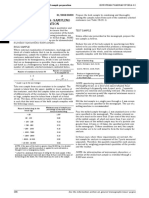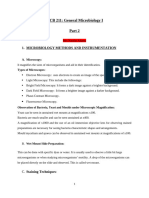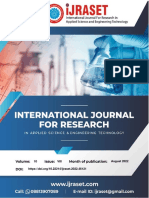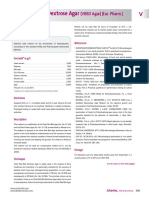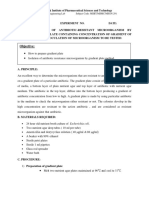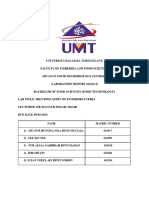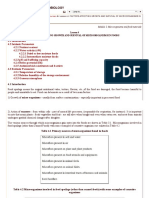Test For Absence of Clostridium Species
Test For Absence of Clostridium Species
Uploaded by
LuisSanabriaSaavedraCopyright:
Available Formats
Test For Absence of Clostridium Species
Test For Absence of Clostridium Species
Uploaded by
LuisSanabriaSaavedraOriginal Title
Copyright
Available Formats
Share this document
Did you find this document useful?
Is this content inappropriate?
Copyright:
Available Formats
Test For Absence of Clostridium Species
Test For Absence of Clostridium Species
Uploaded by
LuisSanabriaSaavedraCopyright:
Available Formats
Accessed from 128.83.63.
20 by nEwp0rt1 on Sat Dec 03 02:18:31 EST 2011
962 〈2022〉 Microbiological Procedures / Dietary Supplements USP 35
monella Enrichment Broth, mix, and incubate at 30° to 35° Test for Absence of Clostridium Species
for 18 to 24 hours. Streak a loopful from both incubated
media onto individual surfaces of one or more of following Test Preparation—Prepare as directed for Sampling.
media: Brilliant Green Agar Medium (BG-Agar), [NOTE—On the basis of results for Preparatory Testing, mod-
Xylose–Lysine–Desoxycholate–Agar Medium (XLDC-Agar), and ify the Test Preparation as appropriate.]
Hektoen Enteric Agar Medium (HE Agar). Cover, invert the
plates, and incubate at 30° to 35° for 24 to 48 hours. Ex- Procedure—Take two equal portions of the Test Prepara-
amine the inoculated plates of BG-Agar, XLDC-Agar, and/or tion, heat one to 80° for 10 minutes, and cool rapidly.
HE Agar, and interpret the results with reference to Table 2: Transfer 10 mL of each portion to separate containers, each
if no colonies having the characteristics described are ob- containing 100 mL of Reinforced Medium for Clostridia, and
served, the test specimen meets the requirement for the ab- incubate under anaerobic conditions at 35° to 37° for 48
sence of Salmonella species. If colonies with characteristics hours. After incubation, subculture each specimen on Co-
described in Table 2 are present, the suspect colonies are lumbia Agar Medium to which gentamicin has been added,
transferred to a slant of Triple Sugar–Iron–Agar Medium (TSI) and incubate under anaerobic conditions at 35° to 37° for
using an inoculating wire, by first streaking the surface of 48 hours. Examine the plates, and interpret with reference
the slant, and then stabbing the wire well beneath the sur- to Table 4: if no growth of microorganisms is detected, the
face. Incubate at 30° to 35° for 24 to 48 hours. If the tubes test specimen meets the requirement for the absence of
do not have red alkaline slants and yellow acid butts, with Clostridium species.
or without concomitant blackening of the butts from hydro-
gen sulfide production, the test specimen meets the require- Table 4. Characteristics of Clostridium Species on Specified Media
ment for the absence of Salmonella species. Medium Gram Stain Catalase
Reinforced Medium for Clostridia (+), rods
Table 2. Characteristics of Salmonella Species on Specified Agar
Columbia Agar (+), rods Negative
Media
Gram If growth occurs, subculture each distinct colony on Co-
Agar Medium Colonial Morphology Stain lumbia Agar Medium, and separately incubate in aerobic and
Small, transparent and color- in anaerobic conditions at 35° to 37° for 48 hours. The
less; or opaque, pink or white occurrence of only anaerobic growth of gram-positive ba-
(often surrounded by pink to cilli, giving a negative catalase reaction, indicates the pres-
Brilliant Green red zone) (–), rods ence of Clostridium sporogenes. To perform the catalase test,
Xylose–Lysine– Red, with or without black transfer discrete colonies to glass slides, and apply a drop of
Desoxycholate centers (–), rods dilute hydrogen peroxide solution: the reaction is negative if
Blue-green, with or without no gas bubbles evolve. If the test specimen exhibits none of
Hektoen Enteric black centers (–), rods these characteristics, it meets the requirement for the ab-
sence of Clostridium species.
Test for Absence of Escherichia coli Retest
Incubate at 30° to 35° for 24 to 48 hours. From FSCD, For the purpose of confirming a doubtful result by any of
pipet a 1-mL aliquot into a container containing 10 mL of the procedures outlined in the foregoing tests following
MacConkey Broth, mix, and incubate at 42° to 44° for 24 to their application to a 10 g specimen, a retest on a 25 g
48 hours. Streak a loopful from both incubated media onto specimen of the nutritional or dietary supplement may be
individual surfaces of MacConkey Agar Medium (MC Agar), conducted. Proceed as directed under Procedure, but make
and incubate at 30° to 35° for 18 to 24 hours. Examine the allowances for the larger specimen size.
inoculated MC Agar plate, and interpret the results with ref-
erence to Table 3: if no colonies having the characteristics
described are observed, the test specimen meets the re-
quirement for the absence of Escherichia coli. Suspect colo-
nies showing the characteristics described in Table 3 are
transferred individually, using an inoculating loop, to the
surface of a plate with Levine Eosin–Methylene Blue–Agar Me-
dium (LEMB-Agar). If a large number of suspect colonies are
〈2023〉 MICROBIOLOGICAL
to be transferred, divide the surface of each plate into quad-
rants, each quadrant being inoculated with a different col-
ATTRIBUTES OF NONSTERILE
ony. Cover the plates, invert, and incubate at 30° to 35° for
24 to 48 hours. If none of the colonies exhibit a characteris-
NUTRITIONAL AND DIETARY
tic metallic sheen under reflected light, and if none exhibit a
blue-black appearance under transmitted light, the test
SUPPLEMENTS
specimen meets the requirement for the absence of Escher-
ichia coli.
The raw materials, pharmaceutical ingredients, and active
ingredients used in the manufacture of nutritional and die-
Table 3. Characteristics of Escherichia coli on MacConkey Agar tary articles may range from chemically synthesized vitamins
Medium to plant extracts and animal byproducts, and these ingredi-
Colonial Morphology Gram Stain ents are typically not sterile. Considerable experience has
Brick red, may have surrounding zone of accrued with these highly refined plant- and animal-derived
precipitated bile (−), rods pharmaceutical ingredients, such as microcrystalline cellu-
lose, modified starch, lactose, and magnesium stearate, and
their microbiological attributes are well established. Botani-
cals may be microbiologically contaminated at any point
during cultivation, harvesting, processing, packing, and dis-
tribution. Major sources of microbial contamination are as-
sociated with human or animal feces used as plant manure,
Official from May 1, 2012
Copyright (c) 2011 The United States Pharmacopeial Convention. All rights reserved.
Accessed from 128.83.63.20 by nEwp0rt1 on Sat Dec 03 02:18:31 EST 2011
USP 35 Dietary Supplements / 〈2023〉 Microbiological Attributes 963
contaminated irrigation water and/or process water, and microbiological contamination and growth. All processes
poor worker hygiene and sanitation practices during har- have to be validated for their intended purposes. Moreover,
vesting, sorting, processing, packaging, and transportation. in-process manufacturing and testing controls necessary for
Furthermore, it is essential that microbiological contamina- microbiological quality should be identified and
tion be minimized during the manufacture of nonsterile die- implemented.
tary supplements. To achieve this, Good Manufacturing
Practices are employed and adequate microbiological speci-
fications are established. FACILITIES, EQUIPMENT, WATER, AND
Microbiological process control, control of the bioburden SANITIZATION
of raw materials, and control of the manufacturing process
to minimize cross-contamination are necessary to guarantee Facilities—The facilities, including the building and the
acceptable microbial quality in the final dosage forms. Be- heating, ventilation, and air-conditioning (HVAC) systems,
cause nonaqueous or dry dosage forms do not support mi- should be designed to minimize microbiological contamina-
crobial growth because of low water activity, the microbial tion. The design of facilities used for the manufacture of
quality of such articles is a function of the microorganisms supplements and their operating parameters should be doc-
introduced through ingredients or during processing. In ad- umented, and the documentation should include, when ap-
dition to considering the intended use of the product, the propriate, HVAC filter types, space pressure differentials,
frequency of microbial testing for the finished nonsterile die- temperature, and relative humidity and air changes. Dry
tary supplement would be a function of the historical micro- products processed in a dry environment do not possess a
bial testing database of that product, knowledge of the high potential for increased microbial levels. However, some
manufacturing processes, the susceptibility of the formula- control is warranted to minimize microbiological and chemi-
tion to microbial proliferation, and the demonstrated effec- cal contamination. Potentially problematic areas are those
tiveness of programs controlling the raw materials. that utilize Purified Water for wet granulation, batching liq-
uid products, and film-coating tablets, because water en-
courages microbial growth.
FORMULATION AND PROCESS DESIGN
Equipment—Equipment used for the processing of semi-
From a microbiological perspective, the development of solid and dry supplements should be designed to promote
the formulation of nutritional or dietary supplements in- sanitary conditions, to be self-drying, and to be easy to
cludes an evaluation of raw materials and their suppliers and clean. Dryers, ovens, wet granulation equipment, bulk tanks,
the contribution made to the products by each ingredient and equipment for preparation of coating solutions are peri-
and the manufacturing processes. Characterization of these odically evaluated to ensure that cleaning procedures are
elements allows the adequacy of the manufacturing process adequate.
to be demonstrated. For example, if a product is formulated Water—As one of the major components in nutritional
with an ingredient of botanical or animal origin known to and dietary supplement manufacturing processes, water de-
possess a high, variable, or unpredictable level of microbio- serves a special consideration in the microbiological control
logical contamination, it is necessary to ensure that the mi- of these articles. It is a growth medium for a variety of mi-
crobiological monitoring identifies ingredients that have an croorganisms that present a threat to product quality,
inappropriate bioburden level and that a premanufacturing safety, preservation, and stability. Water may even act as a
process such as drying, extraction, heat treatment, irradia- carrier of objectionable microorganisms. In view of this,
tion, or gaseous sterilization treatment will inactivate or re- water used in manufacturing is Purified Water. For the manu-
move any objectionable contaminant possibly present. facture of raw materials, process water that meets specific
However, the selected treatment technique should not microbiological objectives and U.S. Environmental Protection
have any adverse effects. The treatment of raw materials by Agency National Drinking Water standards or equivalent Eu-
irradiation and ethylene oxide may cause unwanted changes ropean and Japanese standards may be used.
affecting the safety and efficacy of the raw material. For Cleaning and Sanitization—Detailed and specific clean-
instance, when treated by ethylene oxide, crude extracts ing and sanitization procedures should be evaluated, devel-
containing alkaloids have shown reduced contents of alka- oped, and validated, with special attention given to product
loids. Dry heat treatment has been used for inactivation as contact surfaces. Personnel should possess sufficient knowl-
well, but it requires further evaluation because it may ad- edge of these procedures.
versely affect stability and degradation of the raw material.
With regard to the design of the manufacturing process,
appropriate consideration should be given to the microbio- SUPPLEMENT COMPONENTS
logical effect of wet granulation manufacturing processes.
Wetting of a dry powder can result in increased levels of Raw materials, excipients, and active substances as com-
microorganisms if the granulation is stored prior to drying. ponents of nutritional and dietary supplements can be a pri-
However, it is recognized that the pressure and temperature mary source of microbiological contamination. Specifications
associated with compression of tablets will decrease micro- should be developed and sampling plans and test proce-
bial counts. Antimicrobial activity is also achieved, especially dures should be employed to guarantee the desired micro-
with aqueous preparations, by the addition of chemicals biological attributes of these materials. The nature and ex-
that have known antimicrobial properties and that are com- tent of microbiological testing should be based upon a
patible with the formulation. knowledge of the material’s origin, its manufacturing pro-
However, antimicrobial preservation is not a substitute for cess, its use, and historical data and experience. For in-
Good Manufacturing Practices. A process has to be de- stance, materials of animal or botanical origin that are not
signed to minimize the microbiological population. Operat- highly refined might require special, more frequent testing
ing procedures and temperatures and time limits, including than synthetic products.
holding times, are established to protect the product from
Official from May 1, 2012
Copyright (c) 2011 The United States Pharmacopeial Convention. All rights reserved.
Accessed from 128.83.63.20 by nEwp0rt1 on Sat Dec 03 02:18:31 EST 2011
964 〈2023〉 Microbiological Attributes / Dietary Supplements USP 35
Since members of the family Enterobacteriaceae are a ma- some articles each batch requires sampling and testing. The
jor component of the normal epiphytic and endophytic design of the sampling and testing plans and the kind of
microflora (e.g., members of genera Klebsiella, Enterobacter, attributes examined depend on the application and the type
and Erwinia) and have been associated with the seeds, pods, of the product, the potential for contamination from com-
roots, leaves, and stems of plants of economic importance, ponents and processing, the growth promotion or inhibition
Coliform or Enterobacteriaceae counts will not be an appro- properties of the formulation, and the target population for
priate general microbiological criterion for botanicals. How- the supplement. For example, a powdered botanical may
ever, when it is considered advantageous, Coliform or Enter- have highly variable microbiological attributes so that an in-
obacteriaceae counts may be included in the individual coming batch would be sampled and composite testing
monographs. Typically on new leaves, bacteria predominate would not be advised, while a highly refined botanical ex-
in the microflora, while yeast and filamentous fungi succeed tract may not require routine microbial testing. Similarly,
bacteria and become dominant late in the growing season. products with a low water activity will not be susceptible to
With dried botanicals, the bacterial population will tend to microbial growth during their shelf life provided they are
change from Gram-negative bacteria to Gram-positive spore protected from elevated humidity by their containers.
formers and fungi. Refinement of botanicals from chopped
or powdered plant material to powdered extracts using al-
coholic, alkaline, acid hydro-alcoholic, or aqueous extracting Microbial Enumeration Tests
materials will reduce the likelihood of vegetative microor-
ganisms within the botanical material. The classification of See the Introduction under Microbial Enumeration Tests—
botanical materials is contained in Table 1. Nutritional and Dietary Supplements 〈2021〉. These tests pro-
vide meaningful information regarding the microbiological
acceptability of excipients, active substances, and nonsterile
MICROBIOLOGICAL TESTING supplement formulations. If the individual monograph does
not specify microbial enumeration limits, the guidance pro-
vided in this chapter is used. Acceptable general limits of
microbial levels for raw materials, excipients, and botanical
Frequency of Sampling and Testing products are shown in Table 2; and those for raw materials,
excipients, active ingredients, and other nonsterile finished
Microbiological attribute sampling and testing plans vary articles that are nutritional supplements but do not contain
widely. In some cases no sampling or testing is necessary; in botanicals are shown in Table 3.
other cases periodic monitoring is warranted; and yet for
Table 1. Definitions of a Range of Botanical Materials
Botanical Preparation Definition
Hand-picked portions of the botanical (e.g., leaves, flowers, roots, tubers, etc.)
that are air dried, and chopped, flaked, sectioned, ground, or pulverized to
Chopped or Powdered Botanicals the consistency of a powder.
Extracts are solids or semisolid preparations of a botanical that are prepared by
percolation, filtration, and concentration by evaporation of the percolate. The
extracting material may by alcoholic, alkaline, acid hydro-alcoholic, or aque-
ous in nature. Typically an extract is 4 to 10 times as strong as the original
botanical. The extracts may be semisolids or dry powders termed powdered
Botanical Extracts extracts.
Tinctures are solutions of botanical substances in alcohol obtained by extrac-
Tinctures tion of the powdered, flaked, or sectioned botanical.
Infusions are solutions of botanical principles obtained by soaking the pow-
dered botanical in hot or cold water for a specified time and straining. Typi-
Infusions cally infusions are 5% in strength.
Decoctions are solutions of botanicals prepared by boiling the material in
water for at least 15 minutes and straining. Typically decoctions are 5% in
Decoctions strength.
A fluidextract is an alcoholic liquid extract made by percolation of a botanical
Fluidextracts so that 1 mL of the fluidextract represents 1 g of the botanical.
Dried botanicals to which boiling water is added immediately prior to con-
Botanicals to be treated with boiling water before use sumption.
Table 2. Recommended Microbial Limits for Botanical Ingredients and Products
Recommended Microbial Limit Requirements
Material (cfu/g or mL)
Total Aerobic Microbial Count NMT 105
Total Combined Yeast & Mold Count NMT 103
Bile-tolerant Gram-negative Bacteria NMT 103
Dried or Powdered Botanicals Absence of Salmonella spp. & E. coli in 10 g
Total Aerobic Microbial Count NMT 104
Total Combined Yeast & Mold Count NMT 103
Powdered Botanical Extracts Absence of Salmonella spp. & E. coli in 10 g
Total Aerobic Microbial Count NMT 104
Tinctures Total Combined Yeast & Mold Count NMT 103
Total Aerobic Microbial Count NMT 104
Fluidextracts Total Combined Yeast & Mold Count NMT 103
Official from May 1, 2012
Copyright (c) 2011 The United States Pharmacopeial Convention. All rights reserved.
Accessed from 128.83.63.20 by nEwp0rt1 on Sat Dec 03 02:18:31 EST 2011
USP 35 Dietary Supplements / 〈2030〉 Supplemental Information 965
Table 2. Recommended Microbial Limits for Botanical Ingredients and Products (Continued)
Recommended Microbial Limit Requirements
Material (cfu/g or mL)
Total Aerobic Microbial Count NMT 102
Infusions/Decoctions Total Combined Yeast & Mold Count NMT 10
Total Aerobic Microbial Count NMT 104
Total Combined Yeast & Mold Count NMT 103
Nutritional Supplements with Botanicals Absence of Salmonella spp & E. coli in 10 g
Total Aerobic Microbial Count NMT 105
Total Combined Yeast & Mold Count NMT 103
Botanicals to be treated with boiling water before use Absence of E. coli in 10 g
Table 3. Recommended Microbial Limits for Dietary Supplement Ingredients and Products
Recommended Microbial Limit Requirements
Material (cfu/g or mL)
Total Aerobic Microbial Count NMT 103
Total Combined Yeast & Mold Count NMT 102
Other raw materials and dietary supplement ingredients Absence of E. coli in 10 g
Total Aerobic Microbial Count NMT 103
Nutritional supplements with synthetic or highly refined ingredi- Total Combined Yeast & Mold Count NMT 102
ents Absence of E. coli in 10 g
Absence of Objectionable Microorganisms optimize the pre-harvest conditions for appropriate growth
and the post-harvest handling to achieve consistent quality
See Introduction under Microbiological Procedures for Ab- with minimum variations in the composition of chemical
sence of Specified Microorganisms—Nutritional and Dietary constituents.
Supplements 〈2022〉. Absence of one or more species of ob-
jectionable microorganisms is required in some individual
monographs. PROTOCOL CONTENTS
Test for Aflatoxins—Dietary and nutritional articles con- Black Cohosh (Actaea racemosa L.)
taining botanical products with a history of mycotoxin con- Ginger (Zingiber officinale Roscoe)
tamination are also typically tested for aflatoxins, especially Valerian (Valeriana officinalis L.)
if the material is obtained from roots or rhizomes. See Arti- Elm (Ulmus rubra Muhlenberg)
cles of Botanical Origin 〈561〉 for the details of a test for
aflatoxins. Where necessary, this test is included in the indi-
vidual monograph. GENERAL GUIDANCES
Solid Oral Dosage Forms—Among all dosage forms,
solid oral dosage forms present the lowest microbiological It is recommended that, at a minimum, growers and
risk because of their method of manufacture, low water ac- others involved in the handling and distribution of botanical
tivity, and route of administration. When justified, reduced products should become familiar with and follow the WHO
microbiological testing may be appropriate. Guidelines for Good Agricultural and Collection Practices
Other Concerns—The presence of some microorganisms (GACP) for Medicinal Plants (found at http://www.who.int/
in articles can be an indicator of processes that are not medicinedocs/collect/edmweb/pdf/s4928e/s4928e.pdf .
under microbiological control. For example, Purified Water Commercial trade in natural products occurs in a global
used at some stage of the manufacture of these products market. Material of domestic origin must be produced in
might contain a typical flora of Gram-negative microorgan- compliance with all federal laws of the United States. Mate-
isms. As with pharmaceutical products, inadequate process- rial of foreign origin, imported into the U.S., must be pro-
ing of water and poor maintenance of water systems may duced and transported in compliance with the laws of the
result in the contamination of processed formulations by U.S., the country of origin, and relevant international trea-
Gram-negative microorganisms. ties. These include, but may not be limited to, the
following:
1. The Convention on International Trade in Endangered
Species of Wild Fauna and Flora (CITES) is an interna-
tional agreement between governments. Its aim is to
ensure that international trade in specimens of wild
animals and plants does not threaten their survival.
〈2030〉 SUPPLEMENTAL Information about CITES is available at http://
www.cites.org.
INFORMATION FOR ARTICLES OF 2. The Convention on Biological Diversity (CBD) estab-
lishes three main goals: the conservation of biological
BOTANICAL ORIGIN diversity, the sustainable use of its components, and
the fair and equitable sharing of the benefits from the
use of genetic resources. Each country that has rati-
fied and is a party to the Convention is responsible
This general chapter provides information about several for implementation by means of national enabling
aspects of botanical articles not covered in USP standards legislation that can differ from country to country.
monographs. Although the standards in the monographs 3. The Endangered Species Act (ESA) was originally
address the quality issues associated with botanical plant adopted in 1973. The ESA is a law that aims to pro-
materials, extracts, and preparations of Pharmacopeial arti- tect species of fish, wildlife, and plants believed to be
cles, there is a need to develop appropriate information to threatened with extinction. The ESA is administered
Official from May 1, 2012
Copyright (c) 2011 The United States Pharmacopeial Convention. All rights reserved.
You might also like
- PH Eur 1433 Herbal DrugsDocument2 pagesPH Eur 1433 Herbal DrugsLuisSanabriaSaavedra0% (1)
- The Logic of Immunity Deciphering An EnigmaDocument204 pagesThe Logic of Immunity Deciphering An EnigmaSatyabrataSahaNo ratings yet
- AQA GCSE Bio End of Topic B5Document13 pagesAQA GCSE Bio End of Topic B5joeNo ratings yet
- PH Eur 2.8.20. Herbal Drugs - Sampling and Sample PreparationDocument2 pagesPH Eur 2.8.20. Herbal Drugs - Sampling and Sample PreparationLuisSanabriaSaavedraNo ratings yet
- Europe Medical Cannabis Regulation Jul 2019Document55 pagesEurope Medical Cannabis Regulation Jul 2019LuisSanabriaSaavedra100% (1)
- Production of Traditional MozzarellaDocument58 pagesProduction of Traditional MozzarellarajaytNo ratings yet
- PMFIAS NCERT Biology 6 12 CompilationDocument319 pagesPMFIAS NCERT Biology 6 12 Compilationtakias100% (3)
- Durabloom 88Document5 pagesDurabloom 88Raoul AmoresNo ratings yet
- 1220 en 3Document2 pages1220 en 3Hiba AmroussNo ratings yet
- Condalab Macconkey 1052 - en - 4Document3 pagesCondalab Macconkey 1052 - en - 4Natália DiasNo ratings yet
- BBL™ Mannitol Salt Agar - BDDocument2 pagesBBL™ Mannitol Salt Agar - BDyyewelsNo ratings yet
- MRSA Isolation ProcedureDocument3 pagesMRSA Isolation ProcedureZoe TagocNo ratings yet
- 1060 en 3Document2 pages1060 en 3Melisa NicevićNo ratings yet
- bacteriological eximaniation, GRAM + medium + antibioticsDocument71 pagesbacteriological eximaniation, GRAM + medium + antibioticsanjalipandey.mbbs109No ratings yet
- Violet Red Bile Agar VDocument2 pagesViolet Red Bile Agar Vmustea_ana9616No ratings yet
- 1062Document2 pages1062Nisadiyah Faridatus ShahihNo ratings yet
- Tryptic-Soy-Broth (CASO) Irradiated For The Microbiological Validation of Aseptic Filling (Media FDocument2 pagesTryptic-Soy-Broth (CASO) Irradiated For The Microbiological Validation of Aseptic Filling (Media FOula HatahetNo ratings yet
- Quantitation of Glycocalyx Production in Coagulase-Negative StaphylococcusDocument5 pagesQuantitation of Glycocalyx Production in Coagulase-Negative StaphylococcusOumayma BensalahNo ratings yet
- Simple and Gram StainingDocument4 pagesSimple and Gram Stainingqueenbullex100% (3)
- 182-Article Text-1113-1-10-20201201Document4 pages182-Article Text-1113-1-10-20201201Neni Sri GunartiNo ratings yet
- Inggris 2 - Cara KerjaDocument1 pageInggris 2 - Cara KerjaRyu- MikaNo ratings yet
- Practical Instruction 4Document4 pagesPractical Instruction 4AuliadeviazizahNo ratings yet
- TDS - CCA AGAR - BK204 - BM182 - EN V4.cleanedDocument4 pagesTDS - CCA AGAR - BK204 - BM182 - EN V4.cleanedReza FebryantaraNo ratings yet
- Bio Gram StainingDocument7 pagesBio Gram StainingAlexander Sebastian100% (1)
- Environmental Monitoring ProgramDocument6 pagesEnvironmental Monitoring ProgramMohammed Zubair100% (1)
- Antimicrobial Sensitivity Disk DifussionDocument29 pagesAntimicrobial Sensitivity Disk DifussioncandicealoneNo ratings yet
- Isolation, Identification and Characterization of Salmonella From DuckDocument6 pagesIsolation, Identification and Characterization of Salmonella From DuckAmira Fathini AzmanNo ratings yet
- MCB211 PART TWO-1-1Document23 pagesMCB211 PART TWO-1-1igwiloinnocent456No ratings yet
- TBX Chromogenic Agar (Tryptone Bile X-Glucuronide) ISO: Industry RegulationsDocument2 pagesTBX Chromogenic Agar (Tryptone Bile X-Glucuronide) ISO: Industry RegulationsMinh NguyenNo ratings yet
- Isolation, Screening, Characterization and Maintenance of Amylase Producing Bacteria From SoilDocument7 pagesIsolation, Screening, Characterization and Maintenance of Amylase Producing Bacteria From SoilIJRASETPublicationsNo ratings yet
- PN ChromogenicMediaDocument12 pagesPN ChromogenicMediaNguyen Ngoc ThachNo ratings yet
- Baclight™ Bacterial Viability and Counting Kit (L34856) : Live/DeadDocument5 pagesBaclight™ Bacterial Viability and Counting Kit (L34856) : Live/Deadkasa_10No ratings yet
- Isolation, Identification and Characterization of Amylase Producing Microorganism From SoilDocument9 pagesIsolation, Identification and Characterization of Amylase Producing Microorganism From SoilInternational Journal of Innovative Science and Research TechnologyNo ratings yet
- Baird Parker Agar Base: Intended UseDocument4 pagesBaird Parker Agar Base: Intended UseKishiro LeyritanaNo ratings yet
- Eugon LT 100 BrothDocument2 pagesEugon LT 100 BrothSergei VoychukNo ratings yet
- Article1380184646 - Tatsadjieu Et AlDocument8 pagesArticle1380184646 - Tatsadjieu Et AlNadz BancayaNo ratings yet
- LAB PRACTICE 25 Mesophils_GelAloeVeraDocument3 pagesLAB PRACTICE 25 Mesophils_GelAloeVeralinoisharon9No ratings yet
- Bio K 300 - Clostridium Botulinum Ag (Eng)Document5 pagesBio K 300 - Clostridium Botulinum Ag (Eng)Anthony CrossNo ratings yet
- In-Vitro Anti-Food Poisoning Bacteria and Cytotoxic Activities of Bioactive Compounds Produced by Streptomyces Sp. A10 Isolated From Fermented FoodDocument9 pagesIn-Vitro Anti-Food Poisoning Bacteria and Cytotoxic Activities of Bioactive Compounds Produced by Streptomyces Sp. A10 Isolated From Fermented FoodSabrina JonesNo ratings yet
- VRBDADocument2 pagesVRBDAEga DeviNo ratings yet
- Salmonella Chromogenic Agar 4Document2 pagesSalmonella Chromogenic Agar 4danNo ratings yet
- M121IDocument2 pagesM121INEHA VAGHELANo ratings yet
- Mic254 Lab Report Exp 4Document12 pagesMic254 Lab Report Exp 4NUR SABRINA MOHD SHAH0% (1)
- 1210 en 2 PDFDocument2 pages1210 en 2 PDFDocare HRNo ratings yet
- CLED AgarDocument2 pagesCLED AgarshalinishaanNo ratings yet
- Antibiotic Senstivity of Various Pathogenic Bacteria in Case of Uti and Throat InfectionsDocument25 pagesAntibiotic Senstivity of Various Pathogenic Bacteria in Case of Uti and Throat InfectionsMishel AroraNo ratings yet
- Learn About The Microbiological Analysis of Purified Water and Water For Injection Including The Method For Detection of PathogensDocument8 pagesLearn About The Microbiological Analysis of Purified Water and Water For Injection Including The Method For Detection of PathogensJai MurugeshNo ratings yet
- Conda Enterotest IDDocument2 pagesConda Enterotest IDjonidaballaNo ratings yet
- Biotechnology LabDocument28 pagesBiotechnology Labnareman hassanNo ratings yet
- Sleat, Mah - Clostridium Populeti Sp. Nov., A Cellulolytic Species From A Woody-Biomass DigestorDocument4 pagesSleat, Mah - Clostridium Populeti Sp. Nov., A Cellulolytic Species From A Woody-Biomass Digestorsukanta60No ratings yet
- TBXDocument2 pagesTBXPhat VoNo ratings yet
- Littman Oxgall Agar W/ Streptomycin: Intended UseDocument1 pageLittman Oxgall Agar W/ Streptomycin: Intended UseJUAN PABLO VERGARA REYESNo ratings yet
- Eosin Methylene Blue Agar (EMB) : IndustryDocument2 pagesEosin Methylene Blue Agar (EMB) : Industrysigit the pembalapNo ratings yet
- TC Boite Contact Baird Parker Double Emballage Irradie x30 18125006302 enDocument2 pagesTC Boite Contact Baird Parker Double Emballage Irradie x30 18125006302 enahmed galalNo ratings yet
- 5148 en 1Document2 pages5148 en 1Penny HuynhNo ratings yet
- Diaslide DS-101 InsertDocument7 pagesDiaslide DS-101 InsertshinhyejjNo ratings yet
- Diaslide CLED-MAcConkey UCD-For More Information Click HereDocument7 pagesDiaslide CLED-MAcConkey UCD-For More Information Click HereMikey MadRatNo ratings yet
- Bile Esculin Test MicroDocument2 pagesBile Esculin Test MicroFatma ElzaytNo ratings yet
- 1 Gradient Plate MethodDocument2 pages1 Gradient Plate MethodAritra Adhya50% (2)
- Lab 5-Food MicrobeDocument4 pagesLab 5-Food MicrobeIlyana Shalahudin50% (2)
- Chapter 2Document12 pagesChapter 2promiselucky41No ratings yet
- M17 Agar Terzaghi 115108 (BAL)Document1 pageM17 Agar Terzaghi 115108 (BAL)João PauloNo ratings yet
- Ex3 Group8Document3 pagesEx3 Group8Ray Stephen SantosNo ratings yet
- 1016Document2 pages1016syaemaNo ratings yet
- Lab 3 Advance MicrobDocument13 pagesLab 3 Advance Microbs62106No ratings yet
- Conda Lab Dextrose Sabouraud 1024 - en - 3Document2 pagesConda Lab Dextrose Sabouraud 1024 - en - 3Natália DiasNo ratings yet
- Medical Mycology: Cellular and Molecular TechniquesFrom EverandMedical Mycology: Cellular and Molecular TechniquesKevin KavanaghNo ratings yet
- Usp 35 - (731) Loss On DryingDocument2 pagesUsp 35 - (731) Loss On DryingLuisSanabriaSaavedraNo ratings yet
- Ph. Eur 5.1.8 - Microbiolgical Quality Herbal Medicine Products For Oral UseDocument1 pagePh. Eur 5.1.8 - Microbiolgical Quality Herbal Medicine Products For Oral UseLuisSanabriaSaavedraNo ratings yet
- PH Eur Index 9,1 2 (2016)Document34 pagesPH Eur Index 9,1 2 (2016)LuisSanabriaSaavedraNo ratings yet
- Tgo 93 - 2017Document14 pagesTgo 93 - 2017LuisSanabriaSaavedraNo ratings yet
- CU Inspection Regulation: Annex 16Document30 pagesCU Inspection Regulation: Annex 16LuisSanabriaSaavedraNo ratings yet
- Adaptations Exam Style Questions (+ Mark Scheme)Document24 pagesAdaptations Exam Style Questions (+ Mark Scheme)Becca ANo ratings yet
- Specified Skilled Worker (I) Food and Beverage Manufacturer Skill Measurement Test Study TextbookDocument87 pagesSpecified Skilled Worker (I) Food and Beverage Manufacturer Skill Measurement Test Study TextbookPutri SullivanNo ratings yet
- Sustainability 11 02266 v2Document19 pagesSustainability 11 02266 v2Lady MendozaNo ratings yet
- VSTEP-Reading Test 5Document14 pagesVSTEP-Reading Test 5Mỹ TrinhNo ratings yet
- Microbial Diversity IDocument43 pagesMicrobial Diversity IHilmi IrsyadNo ratings yet
- Heep 102Document6 pagesHeep 102pk2varmaNo ratings yet
- Ece 421Document424 pagesEce 421ruth olatunjiNo ratings yet
- Distribution of Cyclic Imide-Transforming Activity in MicroorganismsDocument5 pagesDistribution of Cyclic Imide-Transforming Activity in MicroorganismsIsmaaNo ratings yet
- (Poster) Louis PasteurDocument1 page(Poster) Louis Pasteurกมลวรรณ อาหาสิเมNo ratings yet
- Section 1: Overview of MicrobiologyDocument8 pagesSection 1: Overview of MicrobiologyJuan Carlos RodriguezNo ratings yet
- Domains Kingdoms and Hierarchy PDFDocument5 pagesDomains Kingdoms and Hierarchy PDFEj FerrerNo ratings yet
- Micro Slides 01 Introduction General MicrobiologyDocument23 pagesMicro Slides 01 Introduction General Microbiologyhamza jassar100% (2)
- Pharmaceutical Microbiology Unit 5Document33 pagesPharmaceutical Microbiology Unit 5Karan PathakNo ratings yet
- Microorganisms: Nisha Gupta Viii Sha Gupta A/B/C/D Science NOTES / Question AnswersDocument14 pagesMicroorganisms: Nisha Gupta Viii Sha Gupta A/B/C/D Science NOTES / Question AnswersDeep ChoudharyNo ratings yet
- COC4 Produce Organic Concoctions and ExtractsDocument6 pagesCOC4 Produce Organic Concoctions and Extractsmamo.sababan.uclNo ratings yet
- 8C Summary SheetDocument2 pages8C Summary Sheet박찬우100% (2)
- Chapter 6: Microbial Growth: Learning Objectives Check Your UnderstandingDocument5 pagesChapter 6: Microbial Growth: Learning Objectives Check Your UnderstandingMd SagorNo ratings yet
- Production Process of Stirred YoghurtDocument3 pagesProduction Process of Stirred YoghurtIftikhar AhmadNo ratings yet
- 4.factors Affecting Growth and Survival of Microorganisms in Foods PDFDocument17 pages4.factors Affecting Growth and Survival of Microorganisms in Foods PDFKumkum CrNo ratings yet
- Microbiology and Parasitology1Document249 pagesMicrobiology and Parasitology1Keshi Wo100% (3)
- Microbiology For The Health Sciences: Chapter 4. Diversity of MicroorganismsDocument59 pagesMicrobiology For The Health Sciences: Chapter 4. Diversity of MicroorganismsHiba Abu-jumahNo ratings yet
- Classification of MicroorganismsDocument37 pagesClassification of MicroorganismsKenix ChanNo ratings yet
- Use of Fungi in Food IndustryDocument27 pagesUse of Fungi in Food IndustrySwateja MangleNo ratings yet
- Week 2. Learning Module Prokaryotic vs. Eukaryotic OrganismDocument25 pagesWeek 2. Learning Module Prokaryotic vs. Eukaryotic OrganismFezaret Jerome C.No ratings yet
- Agri Doc FreeDocument84 pagesAgri Doc Freeনাহিদ হাসান মিঠু0% (1)



